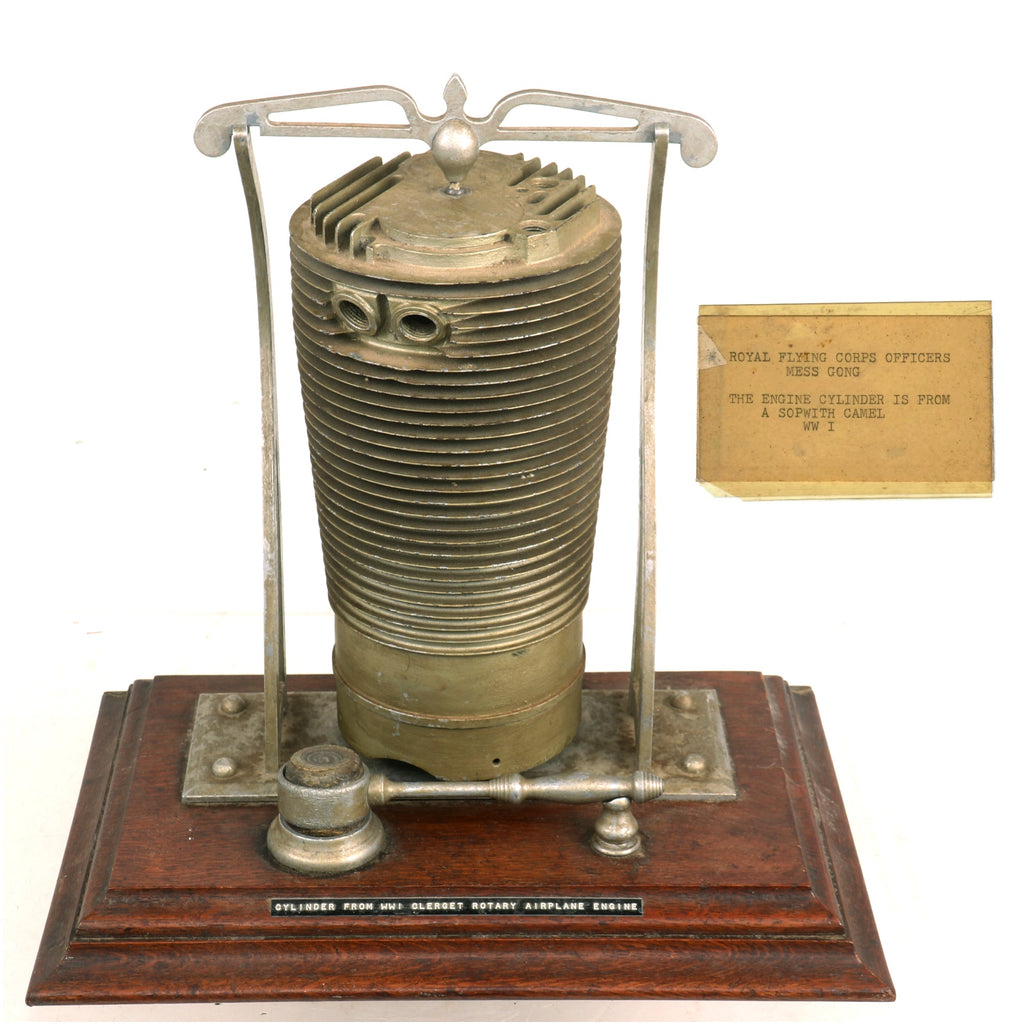Item Description
Original Items: One-of-a-kind. This is a wonderful pair of items for the Royal Flying Corps (RFC), the predecessor of the Royal Air Force (RAF). This is a fantastic British WWI Dinner Gong with a stand and beater, made from one of the cylinders off of a Sopwith Camel, one of the best known aircraft of WWI. It was very common in the British Military items to be repurposed as adornments for regimental museums, clerical offices, and of course, the officer's mess. This came to us with an original tag in old plastic wrapping, which describes the piece:
ROYAL FLYING CORPS OFFICERS
MESS GONG
THE CYLINDER IS FROM
A SOPWITH CAMEL
WW I
There also is a label on the wooden base, which reads:
CYLINDER FROM WWI CLERGET ROTARY AIRPLANE ENGINE
The Clerget 9B was one of several engines used on the Sopwith camel, and we have confirmed with period photographs that this is definitely from a 9B. The gong is mounted on an aluminum stand attached to a 16" x 11" wooden base, and altogether the gong is about 16" tall and weighs 17 lbs.
Really a lovely piece that would look great on a shelf or a desk. It definitely still rings well though honestly it is not very loud and works much better as a display piece.
The Royal Flying Corps (RFC) was the air arm of the British Army before and during the First World War until it merged with the Royal Naval Air Service on 1 April 1918 to form the Royal Air Force. During the early part of the war, the RFC supported the British Army by artillery co-operation and photographic reconnaissance. This work gradually led RFC pilots into aerial battles with German pilots and later in the war included the strafing of enemy infantry and emplacements, the bombing of German military airfields and later the strategic bombing of German industrial and transport facilities.
The Sopwith Camel is a British First World War-era single-seat biplane fighter aircraft that was introduced on the Western Front in 1917. It was developed by the Sopwith Aviation Company as a successor to the Sopwith Pup and became one of the best known fighter aircraft of the Great War.
The Camel was powered by a single rotary engine and was armed with twin synchronized Vickers machine guns. Though difficult to handle, it was highly maneuverable in the hands of an experienced pilot, a vital attribute in the relatively low-speed, low-altitude dogfights of the era. In total, Camel pilots have been credited with downing 1,294 enemy aircraft, more than any other Allied fighter of the conflict. Towards the end of the First World War, the type also saw use as a ground-attack aircraft, partly because the capabilities of fighter aircraft on both sides had advanced rapidly and left the Camel somewhat outclassed.
The main variant of the Camel was designated as the F.1. Other variants included the 2F.1 Ship's Camel, which operated from aircraft carriers; the Comic night fighter variant; and the T.F.1, a "trench fighter" armored for attacks on heavily defended ground targets. A two-seat variant served as a trainer. The last Camels were withdrawn from RAF service in January 1920.
- This product is available for international shipping.
- Eligible for all payments - Visa, Mastercard, Discover, AMEX, Paypal & Sezzle
















